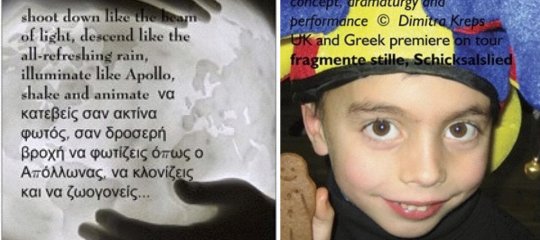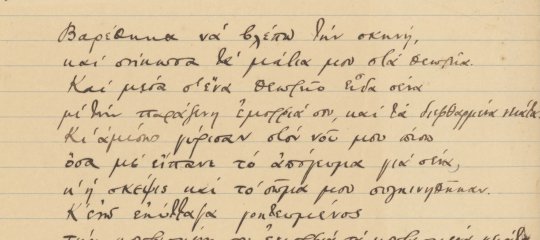Discuss the use of the so-called ‘narrated monologue’ or ‘free indirect speech’ as employed for the first time ever in Greek fiction by Vizuinos.
Discuss the use of the so-called ‘narrated monologue’ or ‘free indirect speech’ as employed for the first time ever in Greek fiction by Vizuinos.
Free indirect Speech or narrated monologue is defined as a narrator taking on the voice of the character since it mixes the medium of direct discourse and first person narrative (Cohn, 1966, pp 97). Vizyenos uses this style of writing to challenge the conventions of literature that developed during the 1880’s. At this time, there was a new wave of literary change which focussed upon ‘naturalism’, traditional Greek life and folklore
. Vizyenos’s use of narrated monologue frames his stories as psychological suspense stories
. We follow the character-narrators perception of events through a rational train of thought; by the conclusion of the story however, the narrator’s perception of events is often reversed. Consequently, the reader’s perception on reality is often reversed as the reader is implicated within the characters narration. Vizyenos’s use of narrated monologue emphasises the strong contrast between the characters perceptions of events and what is often unmasked as the brutal reality of life
. I shall explore how Vizyenos radically redefines the medium of ithografia (literary realism) through narrated monologue; using the style to explore psychologically, the ambiguity of characters identity and morals, with particular emphasis placed on Moscov-Selim, The Only Journey of His Life and The Consequences of the Old Story and reference to Who Was My Brothers Killer?. For the sake of continuity I shall be referring to it hence forth as Narrated Monologue.
By the end of Vizyenos’s stories, the world in which we are presented is one of conflicting realities and merging identities because the narrated monologue in Vizyenos’ work brings into question the nature of identity
. The style of narrated monologue means the character speaks through the voice of the narrator so that they become merged
and Vizyenos uses this to exemplify the transgressed boundaries of his characters. In this sense narrated monologue helps to emphasise the world in which Vizyenos himself grew up in, living in Constantinople
as a Turkomeritis. The term Turkomeritis displaces the importance of identity as it highlights the importance of geographical location. Therefore Vizyenos is outside the spheres of Greek but also not wholly Turkish
. Therefore, like Vizyenos himself, the endings of his stories exemplify how the characters cannot define themselves under one conceptual category nor can they mask themselves under a certain identity
. The grandfather in The Only Journey of His Life cannot pretend he is a well travelled man as he is still confined within the mythological world that he experienced as a female and within Moscov-Selim the characters emotional turmoil at having to define his identity results in death.
The adoption of this mode of writing emphasised the literary style now deemed ‘border writing’
, where there is the potential for narratives to cross over and therefore subvert the unified mindset. Vizyenos forms an exception to the prevailing Greek climate of nationalism
and his mode of writing in which two narratives often contrast one another accentuates the consequences of a uniform idea, such as nationalism, upon the concept of identity. Narrated Monologue within Moscov-Selim is used as a tool to explore national identity and to breakdown the preconceived judgements that are put upon Selim for supporting the national enemy.
Peckam argues that a nationalist view is one based upon homogeneity and difference to affirm identity
. Therefore most literature of the time reflects this emphasise on national difference, a subject of importance with the annexation of Thessaly in 1881, bringing a new goal to redeem those Greeks beyond the nation
. Vizyenos explored the consequences of militant nationalist ideology on identity
. Instead of presenting a uniform concept of identity in Moscov Selim he highlights how nationalism creates further turmoil. In Moscov-Silem, narrated monologue emphasises the merging of cultural identities and reflects the dilemma of Turkomeritis. The world of the characters and the world of the narrator are presented as symmetrical as the narrator’s description of the locality is symmetrical to the characters narration of the story
. Through narrated monologue we are presented with certain narrative similarities that connect the narrator and the character. This contrasted the Post-colonialist attitude that brought the hybridization of cultures and frameworks that defined different identities. Through the medium of narrated monologue Moscov-Silem becomes a type of ‘border writing’ that crosses over and subverts the idea of a unified cultural identity
.
The narrator at the beginning of Moscov-Selim acknowledges that his story will be condemned by the ‘fanatics of [his] race’
. Because of the preconception of Vizyenos’s audiences, narrated monologue enables him to empower the voice of Selim against a popular conception; he divulges the story ‘as a simple chronicler’
even though the realism of communication between a Turk and Greek would have been alien to the contemporary reader. Selim’s identity is preconceived as ‘Some Russian who stayed here after the last war’
. His cottage which was an ‘obvious imitation of the poor dwellings that the Russians peasants call izba’
is a source of contempt for a Turkish community where nationalism was paramount as the setting is the Russo-Turkish war of 1877-8
. The alternative view we are presented with is therefore the alternative side to the discourse of two nations
. Keen argues that narrated monologue has a strong effect on the reader’s response to a character
, through it we are given sympathetic account. Despite this, even the narrator admits that ‘he wronged Selim even if only in thought’ because like the conventional viewpoint he wished to brand Selim with fanatical ‘Russophilia’ without considering the ‘reasons that made Selim deny or reject his racial character’
. Once again within Moscov-Selim, narrated monologue subverts the reader’s expectation as Selim ‘remained a Turk to the last’
. Through narrated monologue we are made to feel sympathy toward Selim and therefore question the notion of nationalism because the narrator notes though they are ‘strangers’ in all matters of religion and nationality their ‘souls are brothers’
. Narrated Monologue is used in Moscov-Selim to highlight the struggle between nationalist ideology that was being promoted in literary culture through periodicals such as Estia
and the crisis of identity that individual’s termed Turkomeritis’s may have faced.
At this time that literature was promoting the Hellenic legacies that were encompassed within those territories unredeemed by the Greek Nation and Turkey and Bulgaria were viewed as intellectually inferior and barbaric
. Through the narrated monologue, it is revealed that Selim’s experiences as a Russian captive are far less barbaric than those under Turkey. Selim had preconceived notions that he would undergo the ‘sufferings’ and ‘deprivation’
that the Russian prisoners had suffered on the Turkish side. The Turkish and Russian hostilities that set the scene for Moscov-Selim offer a metaphorical analogy of the prejudged view of Turkey by Greece fanaticals; through narrated monologue we are offered a different perception on the destructive forces of nationalism.
In contrast to the unprejudiced narrator of Moscov-Selim; within Who was My Brother’s Killer? We are presented with an Ottoman Greek who holds strong prejudices against the Islamic Turks
as his mother knew his ‘hatred for Turks’
she tries to persuade the narrator to listen. Through narrated monologue we are forced to follow the rational train of thought of the narrator as it is shaped by contact with foreigners. Upon retelling Kamils’s experience we see how his preconceived notion is changed from someone who ‘couldn’t stomach’
them to someone who could sympathise with the ‘crazed man’s goodness’
.
In The Consequences of The Old Story, narrated monologue emphasises the antithetical intent in Vizyenos’s stories
. Narrated monologue highlights the delusion the characters have of reality: ‘it usually happens whenever we seek to discover the truth not as it is, but as we want it to be’
. It is through the experiences of the narrator that Paschalis learns that, his love he ‘had promised to return’
to and whom he preconceived to be dead, is in fact alive as he had ‘want[ed] it to be’. The narrator draws attention to “what a terrible thing preconception is”
. Narrated monologue highlights the brutal reality and the irony that the situation could have been absolved.
The intent of narrated monologue within Moscov-Selim is to use narrative similarities to present merged identity. Contrastingly, the dual narratives in The Consequences of The Old Story accentuate the ‘paradoxical relations’
between the characters; specifically the antithetical qualities between Paschalis and Klara. The narrators retelling of Paschalis’s account presents their similarities: they are soul mates that both share a love of music, ice skating and opera
. We learn that Klara is from a privileged background, flirtatious and extravert. However, it is from the narrators separate description of Paschalis that we learn he is ‘pale and anaemic’, has an ‘overworked intellect’
and is poor as he one of the ‘learning starved youths from enslaved Greece’
. Through narrated monologue the reader is given the privileged position to observe how they are separated through their cultural, class and even name difference as one is distinctly German and the other is Greek
. The rational conclusion to draw would be that they could not be together. Vizyenos therefore uses narrated monologue to subvert the reader’s expectation as we are told that he ‘loved her’
. Vizyenos implants a preconceived notion into the reader which is then subverted because we are shown the cruel reality that both would meet each other ‘beneath the azure sky; under the sweet light of paradise’
.
Furthermore, the dual narrative is used to present the antithetical perceptions of one individual, Klara. We are invited to compare their similarities: both are blonde, in love and from the same region of Germany
. Narrated monologue contrasts the preconceived notion Paschalis has of Klara and the brutal reality. In the opening the narrator presents us with a blonde girl thrashing around in a blue padded cell but through Paschalis we are presented with the ‘vision’ of himself and Klara in heaven
. Vizyenos employs the used of Germanic folklore to insinuate the connection between both perspective stories: the mental patient states that her lover ‘went out digging to get diamonds’
and Paschalis is in the process of mining in Klausthal. This evokes the German folk tale ‘Navel of the Earth’ where a young prince must go into the underworld to rescue gems and to stop the princess building a tower out of the heads with her perspective suitors
; this princess rejects many suitors as does Klara. It is only through narrated monologue that we are forced to compare the difference between the folkloric myth that presents the romance of Klara and Paschalis with the reality that these are the words of someone who has lost their mind.
Narrated monologue is used as a literary tool to emphasise Vizyenos’s ‘border writing’: when narratives cross over and thus subvert a unified concept
. Using this technique, Vizyenos highlights the dividing factors of linguistic identity that were occurring during the period of the Diglossia
because Vizyenos’s characters converse in the demotic style while the narrator displays his knowledge of both forms. Narrated monologue allows Vizyenos to highlight the organic verse against state imposed idiom, orality against the written word
. This is evident in The Journey of His Life where the child only understands demotic form; however the adult narrator has learned and uses written form. Were it not for narrated monologue, where the character speaks through the voice of the narrator
, this contrast between written and spoken would not be as evident.
Folklore was constructed within literature at this time as a way of bridging the gap between Modern Greek’s and their predecessors. By doing this, literature offered verification for the nation states foundation
because the contemporary nation encompassed a much smaller area than its ancient state. However narrated monologue within the Only Journey of His Life, presents the breakdown of folklore as the boy’s narrative story contrasts the grandfather’s mythological ideas. Within The only Journey of his life, the juxtaposition between reality and a characters preconceived idea of reality is made to seem greater because the events are narrated through the eyes of a child. Vizyenos uses narrated monologue to radically challenge the medium of ithografia because in the opening of the book we are presented with a mythological story which seems implausible. The narrator describes ‘forty nereids’
, mythical creatures, helping the taylor-boy sew. We are presented with the narrator’s preconceived notion of what reality is, the world of his grandfather’s grandmother and as a consequence of narrated monologue we are made to view reality through his eyes therefore allowing the boundaries of fantasy and reality to be merged
as they merge in the mind of the 10 year old narrator. The narrator, living in the ‘Golden Times’
of travel and education is forced to change his perception of this world, as we are, and confront the boundaries of reality and fantasy. At the end of the story we are left with a sense of grief for the passing not only of a grandfather but of a way of life unchanged in the eyes of the grandfather and grandmother. Narrated monologue emphasises how folklore is a false conception and it can be argued is used to emphasise Vizyenos own contradictory views about how it was being employed within literature at the time.
Furthermore narrated monologue only serves in illuminating the naivety of the grandfather. Through narrated monologue, the worlds of the grandfather and grandson are merged as ‘the promises had created so attractive an impression on [his] childish imagination’
. This renders their separation at the end more poignant and brutal. Contrastingly, the narrator in The Consequences of the Old Story leaves the reader with the impression that Paschalis and Klara’s souls have merged
. Vizyenos uses narrated monologue to merge identities of characters. Within both stories this only serves to highlight their brutal reality.
Narrated monologue is also a tool used to explore sexual identity which is often inextricably bound up with national identity
. Barbeito uses the term transvestite effect to describe the ‘blurring of conceptual categories’
. This is evident within Moscov-Selim where the narrator explains with Selim ‘no stranger outfit could have been created’
. Within Selim’s tale the narrator chooses to recount Selim’s childhood cross-dressing. Dress is an emblem of the dual identities of Selim; when understanding his childhood we can sympathise with the reason behind his dress as an adult. Similarly within The Only Journey of his life we learn through the narrator’s recount that the Grandfather was “dressed ... up in girls’ clothes”
as a child. The dressing up of boys as girls was done to evade the janissaries as they would ‘gather up the Christian boys and make Turks of them’
. The house and the inside domain is associated with the woman; a role which he cannot escape as it is his wife who adopts the manly role of travelling and going on pilgrimage. The disappointment the childish narrator feels at this news in hindsight turns to sympathy when it is diverged that death will be ‘the only journey of his life’
. Through narrated monologue we come to sympathise with the characters unconventional view, a consequence of their blurred sexual identity. The Grandfathers mythological outlook on life unconventional because he is still trapped within the traditional female domain, where mythological stories are his only means of understanding the outside world.
Through narrated monologue, we follow the boy narrator as he disentangles his idea of reality from that of his Grandfather; this includes subverting his idea of sexuality from the one his Grandfather grew up with. The romanticised image the child exhibits of ‘princesses’ later becomes a ‘filthy, wrinkled, wide-mouth old moor’
, a human hybridization known as a eunuch. These creatures like the Mermaids that inhabit the frontier zone of Herodotean stories seem distant but as we learn through the sympathetic ear of our narrator, reflect the paradox of the Grandfather who was brought up a to be woman and a Christian in a Muslim empire
. Narrative monologue is used again to subvert the reader’s idea; the hybridised creatures of the Grandfathers mythological world reflect the reality of the boundaries he straddles.
Through the use of narrative monologue, Vizyenos deconstructs ideas of folkloric movement, self-representation and the establishment of national identity. These ideas were finding foundation at that time. The twists which are offered at the end of his stories as a result of his narrative style emphasise the uncertainty and ambiguity of these themes. Furthermore, through narrated monologue, the borders of the stories themselves as characters, places and incidents reoccur are redefined and thus Visyenos challenges are preconceived notions and the strong beliefs held by the Greek populace at the time.
Bibliography
Alexiou, M. 1993. Writing Against Silence: Antithesis and Eckphrases in the prose fiction of Vizyenos. Dumbarton Oaks Papers: Vol 47 pp 263-286
Barbeito, P.F. 1995 Altered States: Space, Gender, and the (Un)making of identity in the Shirt Stories of Georgios M.Vizyenos. Journal of Modern Greek Studies: Vol 13 pp 299-324
Beaton, R. 1994, An introduction to Modern Greek Literature, Oxford: Oxford University Press.
Chryssanthopoulos, M. 1998. Reality and Imagination: The Use of History in the Short Stories of Yeoryios Viziinos. In: The Green Novel AD 1-1985, Croow Helen.
Cohn. D, Spring 1966, Narrated Monologue: Definition of a Fictional Style, Comparative Literature, Vol. 18, No. 2, pp. 97-112
Keen, S. 2007. Empathy and the Novel, Oxford: Oxford University Press
Stevenson. R, 1992, Modernist Fiction: An Introduction, Malaysia: Pearson Educated Limited pp.32
Wyatt, W.F, 1988, My Mother’s Sin and Other Greek Stories by Georgios Vizyenos, Hanover and London: Brown University Press
- Εισέλθετε στο σύστημα για να υποβάλετε σχόλια











